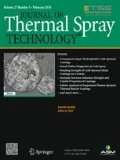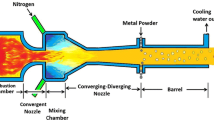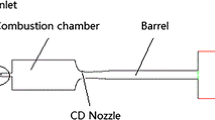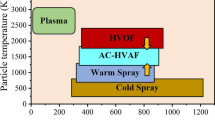Abstract
The fluid and particle flow field characteristics of a high-velocity oxygen-fuel (HVOF) thermal spray (TS) system are analyzed using a two-phase flow model and simulated using computational fluid dynamics (CFD) techniques. The model consists of a conservation equation and constitutive relations for both gas and particle phases. Compressible, turbulent flow is modeled by ak-ɛ turbulent model. A Lagrangian formulation is used to model particle trajectory, and heat and momentum transfer. The fluid velocity fluctuations resulting from gas turbulence are simulated by a stochastic model and the particle motion in the turbulent flow is calculated in a Lagrangian Stochastic-Deterministic (LSD) method. Details of gas flow field, particle temperature and particle velocity histories, and particle temperature and velocity profiles in the system are presented. For the validation of the numerical analysis, the computed results are compared with available experimental measurement. Excellent agreement between simulations and measurements is obtained for both gas and particle flow fields. A parametric study is also conducted for different particle sizes and different nozzle barrel lengths. The flow phenomena for different flow parameters are analyzed and explained as the result of gas dynamics and heat and momentum transfer between the two phases. The developed methodology provides a means to analyze, design, and optimize the TS process. The numerical analysis presents a first comprehensive, fundamental quantitative analysis for the HVOF TS system.
Similar content being viewed by others
References
A.S. Brown, Spraying for Strength,Aerosp. Am., Jan 1992, p 52–56
M. Thorpe and H. Richter, A Pragmatic Analysis and Comparison of the HVOF Process,Thermal Spray Coatings: Research, Design, and Applications, C.C. Berndt and T.F. Bernecki, Ed., ASM International, 1993, p 157–167
E. Oberkampf and M. Talpallikar, Analysis of a High Velocity Oxygen-Fuel (HVOF) Thermal Spray Torch, Thermal Spray Industrial Applications, C. Berndt and S. Sampath, Ed., ASM International, 1994, p 381–386
E. Kadyrov, Y. Evdokimenko, V. Kisel, V. Kadyrov, and F. Worzala, Interaction of Particles with Carrier Gas in HVOF Spraying Systems,J. Therm. Spray Technol, Vol 3, 1994, p 389–397
C. Crowe and D. Stock, A Computer Solution for Two-Dimensional Fluid-Particle Flows,Int. J. Numer. Methods Eng., Vol 19, 1976, p 185–196
P.P. Chen and C.T. Crowe, On the Monte-Carlo Method for Modeling Particle Dispersion in Turbulence,Symposium Gas-Solid Flows, American Society of Mechanical Engineers, 1984, p 37–42
H. Speziale, R. Abid, and E. Anderson, “A Critical Evaluation of Two-Equation Models for Near Wall Turbulence,” Paper 90-1491, American Institute of Aeronautics & Astronautics, 1990
J. Morrison, “Flux Difference Split Scheme for Turbulent Transport Equations,” Paper 90-5251, American Institute of Aeronautics & Astronautics, 1990
PL. Roe, Approximate Riemann Solvers, Parameter Vectors, and Difference Schemes,J. Compt. Phys., Vol 43, 1981, p 357–372
D. Milojevic, Lagrangian Stochastic-Deterministic (LSD) Prediction of Particle Dispersion in Turbulence,Part, and Part. System Characterization, Vol 7, 1990, p 181–190
M. Sommerfeld, Modeling of Particle/Wall Collision in Confined Gas-Particle Flows,Int. J. Multiphase Flow, Vol 18. 1992, p 905–926
C T. Crowe, M.P. Sharma, and D.E. Stock, The Particle-Source-In Cell (PSI-CELL) Model forGas-DropIet Flows.ASME.J. Fluids Eng.. Vol 99 (No. 2), 1977, p 325–332
P.J. Thomas. On the Influence of the Basset History Force on the Motion of a Particle through a Fluid.Phys. Fluids A, Vol 4, 1992, p 2090–2093
R. Clift. J.R. Grace, and M.E. Weber.Bubbles, Drops and Particles, Academic Press, 1978
I. Gary. Higher Velocity Thermal Spray Processes Produce Better Aircraft Engine Coatings. JAE 28th Ann. Aerospace/Airline Plating & Metal Finishing Forum & Exposition (San Diego, CA), April 1992
W.D. Swank, J.R. Fincke, DC. Haggard, and G. Irons, HVOF Gas Flow Field Characteristics,Thermal Spray Industrial Applications. C. Berndt and S. Sampath, Ed., ASM International, 1994, p 313–318
S. Gordon and B. McBride, “Computer Program for Calculation of Complex Chemical Equilibrium Compositions. Rocket Performance. Incident and Reflected Shocks, and Chapman-Jouguet Detonations.” SP-273, National Aeronautics and Space Administration, May 1976, new version, 1989
W.D Swank, J.R. Fincke, and D.C Haggard, HVOF Particle Flow Field Characteristics,Thermal Spray Industrial Applications, C. Berndt and S. Sampath. Ed., ASM International, 1994, p 319–324
S. Eidelman and X. Yang, Optimization of the Thermal Spray Guns and Coating Processes Using Numerical Simulation, Annual Meeting and Exhibition (Anaheim, CA), Feb 1996, TMS
Author information
Authors and Affiliations
Rights and permissions
About this article
Cite this article
Yang, X., Eidelman, S. Numerical analysis of a high-velocity oxygen-fuel thermal spray system. JTST 5, 175–184 (1996). https://doi.org/10.1007/BF02646431
Issue Date:
DOI: https://doi.org/10.1007/BF02646431




